Driven: Mighty Porsche Cayman comes of age
BY BYRON MATHIOUDAKIS | 31st May 2013

Kicking off at $107,100 plus on-road costs, or $139,900 for the higher-spec S, the all-new 981 series Cayman costs between $2300 and $8000 less than its predecessor.
Related to the latest 911, the Cayman’s party trick is that it’s measurably bigger and 40 per cent torsionally more rigid, yet up to 30kg lighter than before (as well as five per cent lighter than the Boxster that it’s based on), This helps render a 15 per cent decrease in fuel consumption and emissions from more powerful its engines.
Larger wheels fill the completely redesigned body, which differs from the Boxster in having changes in the way the bumpers, front air intake, front fog lights, rear diffuser, and pop-up spoiler look and/or operate.
The vehicle is 30mm longer overall, but with a cut in front overhang, the wheelbase has seen a considerable 60mm stretch, for a sizeable leap in cabin space for the two occupants inside.
Click in the 'Quick Tests' box to the right for full review...Key measurements are 4380mm (length), 1801mm (width), 1294mm (height), and 2457mm (wheelbase).
Aluminium is utilised more than before, accounting for around 44 per cent of overall construction. It is found in the bonnet (housing a 150-litre storage area), doors, hatch (offering 275 litres of cargo space), and superstructure underneath, combining in parts with deep-drawn steel (roof, pillars, mudguards and rear flanks), high-strength steels (sills and various other underbody bits), and advanced/ultra high-strength steels (front and rear header rail, footwell region, door intrusion beams) for maximum rigidity.
A total of 425 litres of storage space (versus 280 litres in the Boxster) makes for a 15-litre improvement over the last Cayman.
With the engine mounted just back of centre amidships, the 981’s yaw, roll and pitch axis virtually intersect right where it is at, Porsche says. The front to rear weight balance ratio is 46:54, while the front and rear tracks are approximately 36mm and 18mm wider at 1526mm and 1536mm in the Cayman respectively.
Suspension continues to be MacPherson struts all round, but with lighter components where necessary, and with wishbones helping support the rear axle, while larger discs form a revamped brake system featuring stiffer callipers, optimised pad guidance, and improved cooling.
But the really big news is the adoption of electric rack and pinion steering, which contributes strongly to the Cayman’s overall efficiency gains.
The all-new Euro-V rated 2.7-litre direct injection flat six-cylinder aluminium engine (0.2-litres down from before) produces 202kW of power at 7400rpm and 290Nm of torque between 4500rpm and 6500rpm, for a power output per litre of 74.6kW.
Driving the rear wheels is a choice of a six-speed manual or seven-speed PDK dual-clutch transmission – which now offers a ‘sailing’ function which allows the engine to run in neutral when coasting along to save fuel.
Porsche is reserving its new seven-speed manual gearbox for the 911 for now.
The 0-100km/h sprint-time takes 5.7 seconds (PDK: 5.6s), while top speed is 266km/h (PDK: 264km/h), and the NEDC combined average fuel consumption figure is 8.2 litres per 100km (PDK: 7.7L/100km). Carbon emissions are 192 grams per kilometre (PDK: 180g/km).
Meanwhile, the Cayman S uses a revised version of its predecessor’s direct-injection 3.4-litre flat six unit, delivering 239kW at 7400rpm and 370Nm from 4500rpm to 5800rpm, for a 69.6kW/L output, 5.0s 0-100km/h rating (PDK: 4.9s), 283km/h V-max (PDK: 281km/h), and consumption/emissions levels of 8.8L/100km (PDK: 8.0L/100km) and 206g/km (PDK: 188g/km) respectively.
Optioning up the $2428 Sports Chrono Package with special launch-control software shaves around 0.2s off the acceleration times in PDK-equipped cars.
Other elements important to the Cayman’s efficiency hikes include electrical system recuperation that charges the battery during braking and coasting phases, saving on alternator output, while map-controlled thermal management works on the engine and transmission cooling systems in a more systematic manner for more optimised operating temperatures.
A new-generation of option upgrades include PASM active damping for improved control and ride qualities, while the PTV torque vectoring system works on the rear differential lock and brakes for more precise steering response through corners.
The park brake is now electric, a hill-hold function has been introduced in the PDK, while larger wheels (beginning with 18-inch items, ranging up to 20-inch alloys) have been incorporated, with reduced rolling resistance tyres to help cut consumption.
Aerodynamics have been improved (though the drag co-efficiency rating of 0.30 is the same as before), with up to 25 per cent reduced lift at both axles for better high-speed stability and control.
A rear spoiler unique to the Cayman has a 40 per cent larger surface area than on the old car’s since it is melded into the lipped tail-lights.
The cabin is essentially the same as found in the Boxster, and offers new options such as automatic radar-controlled cruise control, keyless entry and drive, and more modern media user interface and connectivity.
According to Porsche Cars Australia managing director Michael Winkler, around 150 to 200 Caymans will find homes this year, with the S accounting for two-thirds of volume. 80 per cent of customers choose the $5300 PDK option.
About two Boxsters are sold for every one Cayman in Australia – a ratio PCA expects will continue with the 981 series vehicles.
Porsche 981 Cayman pricing*
| Cayman | $107,100 |
| Cayman PDK (a) | $112,400 |
| Cayman S | $139,900 |
| Cayman S PDK (a) | $145,200 |